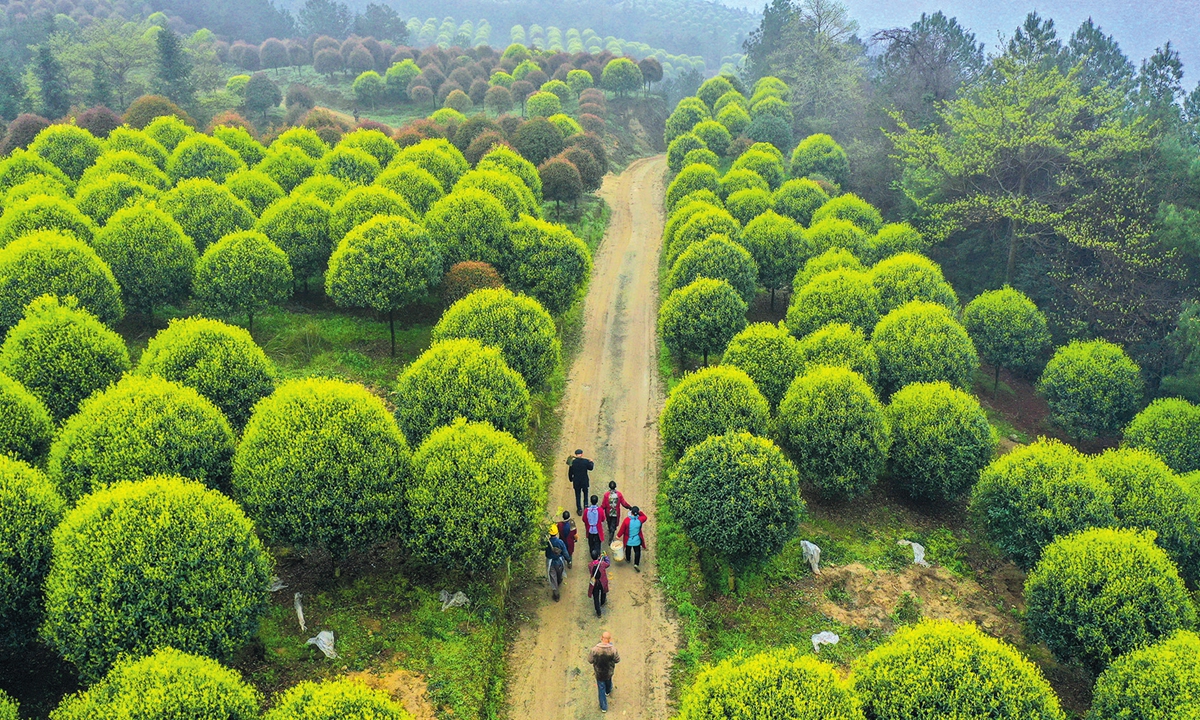IN-DEPTH / IN-DEPTH
Improving ecology and air quality via afforestation

Villagers walk home after planting trees in Changxing Forestry Farm in Zigong, Southwest China's Sichuan Province, on March 11, 2021. Photo: VCG
The Chinese people have long been a major force in creating expansive greener lands and bluer skies. From the forestation campaign that started decades ago to the planting of "virtual trees" on mobile phones today, thanks to the unremitting efforts of the Chinese people, the country's forest coverage rate has increased from 8.6 percent in the early years of the People's Republic of China to 23.04 percent in 2020.
Against the backdrop of an overall decline in global forest resources, China has maintained an increasing trend in forest area and forest stock volume for more than 30 consecutive years, the People's Daily reported.
Behind these miracles, vivid stories and innovative measures illustrate China's efforts dedicated to the improvement of air quality and the ecological environment.
"Sandstorms blow once a year and last for half a year," was once a common phrase to describe the ecology in Horqin Right Wing Middle Banner, North China's Inner Mongolia Autonomous Region.
"In the past, due to overgrazing, the pasture would be eaten away by cattle and sheep before the rainy season, turning cropland into sand," 54-year-old forest ranger Baijilin Baiila told the Global Times. "Thanks to the ecological forests now planted, there is little dust even when the wind blows hard," he noted.
In 2018, thanks to a promotion conducted by local authorities, the "Ant Forest" project, a nonprofit project to combat desertification and promote a low carbon lifestyle started by Chinese e-commerce giant Alibaba landed in Baijilin Baiila's village, and 100 hectares of sea-buckthorn seedlings amounting to 70,000 seedling units were planted in the desert.
Under the recommendation of the village, Baijilin Baiila became a ranger, patrolling 300 acres of the forest allows Baiila to earn an extra income of 10,000 yuan ($1556) per year. Combined with dividends from the sea-buckthorn forest and income from the cattle industry, he could earn more than 50,000 yuan every year.
Baijilin Baiila has a deep affection for this sea-buckthorn forest. "In the early years, our village also organized planting trees, but due to the lack of professional knowledge, few trees survived. Afterward, we did not have the enthusiasm to plant trees," he said, noting that now relevant departments invite professionals to carry out scientific planting, and villagers act as forest rangers to guard.
"Large patches of forest were planted, which not only changed the environment of the surrounding villages and towns, but also changed the minds of villagers," he said.
Data shows that as of 2020, the village where Baijilin Baiila is based has returned nearly 3333 hectare of cultivated land to forests and grassland. The comprehensive vegetation coverage of grassland in the whole Horqin Right Wing Middle Banner has increased from 35.17 percent in 2016 to 63 percent in 2020, with an average reduction of 21 days in sandy weather compared with the same period in 2016.
Meanwhile, currently, programs like "Ant Forest," which combined online and real tree-planting projects, are becoming increasingly popular in China. Authorities in different places are encouraging people to carry out certain public benefit drives to "adopt" saplings on the internet, as well as participate in the volunteer services of afforestation and tree management when they are free.
By 2020, the total number of participants in the interactive online program "Ant Forest" had exceeded 500 million, and 39,000 hectares of trees had been planted offline.
"China's increasing leafiness has been evident for some time," the BBC reported, noting that the scale of carbon dioxide absorption by new forests in some parts of China has been underestimated.
During the 13th Five-Year Plan period (2016-20), China imposed a moratorium of all commercial logging of natural forests nationwide. A national management and conservation team involving nearly 7 million people has been set up, taking advantage of remote monitoring and drones, and other technical means to strengthen the monitoring and protection of forest resources.
The Chinese government has also funneled more than 10 billion yuan in forestry management subsidies to convert more than 1 million poverty-stricken residents into ecological rangers, raising more than 3 million people out of poverty.
With the arrival of winter, the dry season also arrived as scheduled in the Daliang Mountains in Southwest China's Sichuan Province. Agamizza, a 45-year-old Yi forest ranger in Puge county with more than a decade of experience in planting trees, is growing increasingly concerned about forest fire prevention.
"People in Daliang Mountains expended a lot of effort on the afforestation of the barren hills. I can't let everyone's efforts go to waste," he told the Global Times.
Agamizza spent his youth living deep in the mountains where vegetation was sparse and the dry and hot valley landscape made the area sandy on sunny days and prone to landslides whenever it rained.
Fortunately, the concept of planting trees to protect the ecology and develop economic forests began to come into Agamizza's life in 2010, when he joined the local state-owned forestry farm, and later also followed the village cooperative to plant walnut forests. In recent years, as he went from guaranteeing basic subsistence to living a better-off life, Agamizza was also pleased to see the environment around him become greener and the resulting occurrence of fewer natural disasters.
In addition to Puge county, forestry farms are currently developing prosperously all over China. East China's Fujian Province has launched "forest ecological bank" pilot projects, relying on state-owned forestry farms to conglomerate disparate forest resources in the form of trusteeships, cooperative management, and mortgage guarantees.
